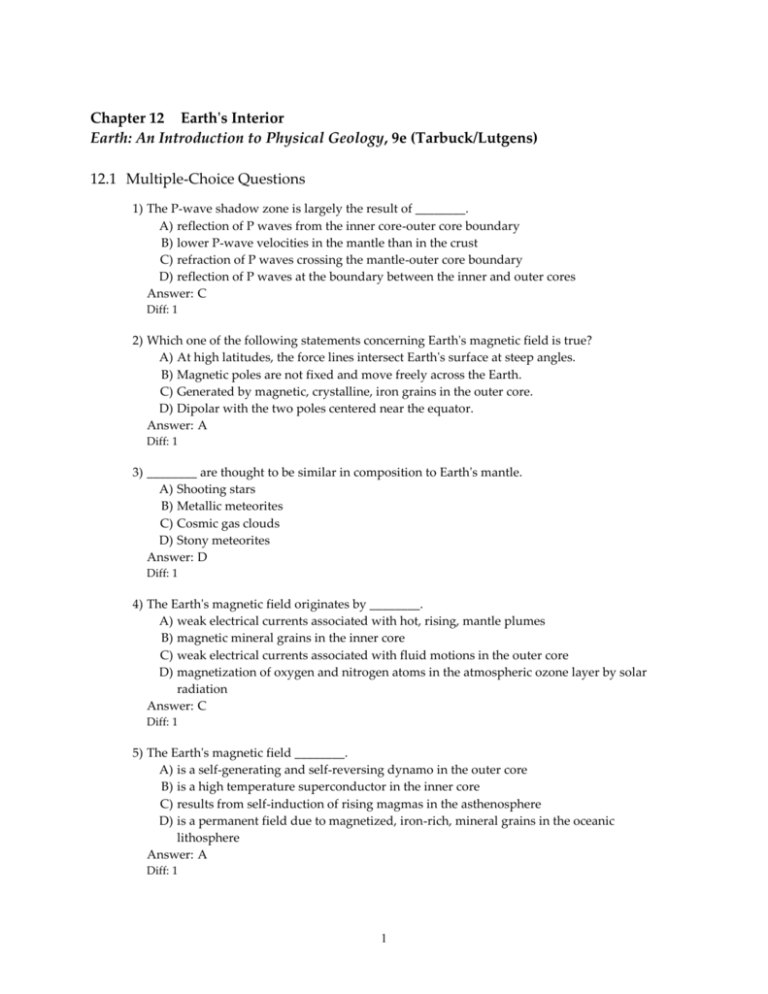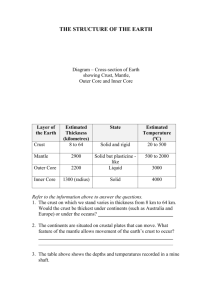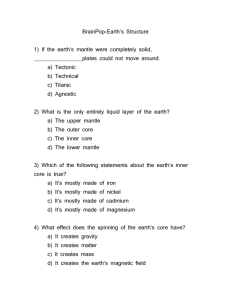Earth,Tests,Ch12
advertisement

Chapter 12 Earth's Interior Earth: An Introduction to Physical Geology, 9e (Tarbuck/Lutgens) 12.1 Multiple-Choice Questions 1) The P-wave shadow zone is largely the result of ________. A) reflection of P waves from the inner core-outer core boundary B) lower P-wave velocities in the mantle than in the crust C) refraction of P waves crossing the mantle-outer core boundary D) reflection of P waves at the boundary between the inner and outer cores Answer: C Diff: 1 2) Which one of the following statements concerning Earth's magnetic field is true? A) At high latitudes, the force lines intersect Earth's surface at steep angles. B) Magnetic poles are not fixed and move freely across the Earth. C) Generated by magnetic, crystalline, iron grains in the outer core. D) Dipolar with the two poles centered near the equator. Answer: A Diff: 1 3) ________ are thought to be similar in composition to Earth's mantle. A) Shooting stars B) Metallic meteorites C) Cosmic gas clouds D) Stony meteorites Answer: D Diff: 1 4) The Earth's magnetic field originates by ________. A) weak electrical currents associated with hot, rising, mantle plumes B) magnetic mineral grains in the inner core C) weak electrical currents associated with fluid motions in the outer core D) magnetization of oxygen and nitrogen atoms in the atmospheric ozone layer by solar radiation Answer: C Diff: 1 5) The Earth's magnetic field ________. A) is a self-generating and self-reversing dynamo in the outer core B) is a high temperature superconductor in the inner core C) results from self-induction of rising magmas in the asthenosphere D) is a permanent field due to magnetized, iron-rich, mineral grains in the oceanic lithosphere Answer: A Diff: 1 1 For the following question(s), match the layers of the Earth with the appropriate description. A. inner core B. mantle C. crust D. outer core 6) ________ upper part of the lithosphere includes this layer Answer: C Diff: 1 7) ________ very dense, solidified, iron-rich alloy Answer: A Diff: 1 8) ________ Earth's magnetic field originates in this layer Answer: D Diff: 1 9) ________ transmits P waves but not S waves Answer: D Diff: 1 10) ________ the top of this layer is marked by the Mohorovicic discontinuity Answer: B Diff: 1 11) ________ includes the asthenosphere Answer: B Diff: 1 12) ________ includes large percentages of feldspars and quartz Answer: C Diff: 1 13) Which of the following best characterizes how the diameter of Earth's core and the nature of the outer core were discovered? A) Crystalline iron was found in lavas erupted from the deepest known hot spots. B) By analysis of the P-wave and S-wave shadow zones. C) Because P-wave speeds are higher in the outer core than in the lower mantle. D) By using the ratio of iron meteorites to stony meteorites to deduce the relative diameters of the core and mantle. Answer: B Diff: 1 14) ________ discovered the crust-mantle seismic discontinuity in ________. A) Beno Gutenberg; 1936 B) Petrovich Divacs; 1914 C) Charles Richter; 1888 D) Andrija Mohorovicic; 1909 Answer: D Diff: 1 2 15) The fact that ________ is good evidence for a solidified, inner core. A) S waves do not pass directly through the core B) P waves are faster in the inner core than in the outer core C) S waves are slower in the inner core than in the outer core D) S waves are focused at the center of the P-wave shadow zone Answer: B Diff: 1 16) Dense forms of ________ are probably major components of the inner core. A) solid iron silicates and magnesium silicates B) crystalline iron and nickel C) liquid iron-nickel-sulfur alloy D) solidified uranium and other very heavy elements Answer: B Diff: 1 17) The ________ of the Earth does not transmit S waves. A) outer mantle B) inner crust C) outer core D) deep mantle Answer: C Diff: 1 18) The ________ is the seismic discontinuity that forms the boundary between the crust and mantle. A) Mojo B) Moto C) Mogo D) Moho Answer: D Diff: 1 19) The ________ of the Earth has the smallest volume. A) crust B) outer core C) mantle D) inner core Answer: A Diff: 1 20) The ________ of the Earth is enriched in the elements silicon, potassium, sodium, and aluminum compared to the most common types of stony meteorites. A) inner core B) outer core C) mantle D) crust Answer: D Diff: 1 3 21) ________ are much more abundant in mantle rocks than in crustal rocks. A) Potassium aluminum silicates B) Quartz and calcite C) Magnesium silicates D) Hydrous minerals like micas and clays Answer: C Diff: 1 22) A mixture of ________ represents the average chemical composition of the continental crust. A) quartz and calcite B) average shale and andesite C) olivine and peridotite D) basalt and metallic iron Answer: B Diff: 1 23) ________ is probably closest in chemical composition to the upper mantle. A) Granite B) Shale C) Andesite D) Peridotite Answer: D Diff: 1 24) ________ are closest to the average chemical composition of the oceanic crust. A) Basalt and gabbro B) Granite and limestone C) Andesite and granite D) Rhyolite and diorite Answer: A Diff: 1 25) Which one of the following best characterizes the asthenosphere? A) a layer of soft, solid, magnesium silicates and molten iron droplets at the base of the mantle B) a zone of hardened, silicate rock at the base of the oceanic crust C) a zone of softened peridotite in the upper mantle D) the zone in the mantle from which hot-spot magmas are melted Answer: C Diff: 1 26) A shallow-focus earthquake occurs directly under the South Pole. A seismic station at the North Pole would receive ________. A) S waves from this quake but not P waves B) both P and S waves from this quake separated in arrival times by two minutes C) neither P waves nor S waves from the quake D) P waves from this quake, but no S waves would be detected Answer: D Diff: 1 4 27) Convection in the mantle causes ________. A) warm rock to rise as narrow pipe-like plumes B) warm rock to rise as tabular sheets C) cool rock to rise as vertical, pipe-like masses D) cool rock to rise as tabular sheets Answer: A Diff: 1 For the following question(s), match the phrases with the appropriate descriptions. A. the "D" layer B. the low-velocity zone C. the mesosphere D. the 660-km-depth discontinuity 28) ________ zone of incipient partial melting in the upper mantle Answer: B Diff: 1 29) ________ most of the lower mantle; more rigid than the asthenosphere Answer: C Diff: 1 30) ________ caused by the transition from the spinel to the perovskite mineral structure Answer: D Diff: 1 31) ________ implicated in the upward flow of warmed mantle from near the core-mantle boundary Answer: A Diff: 1 12.2 Word Analysis Questions Examine the words and/or phrases for each question below and determine the relationship among the majority of words/phrases. Choose the option which does not fit the pattern. 1) A) crust B) lithosphere C) core D) mantle Answer: lithosphere Diff: 1 2) A) core Answer: core B) asthenosphere C) mesosphere D) lithosphere B) peridotite C) perovskite D) granodiorite Diff: 1 3) A) kimberlite Answer: granodiorite Diff: 1 5 12.3 True/False Questions 1) Oceanic crust is mainly basaltic in composition; the mantle is more like the igneous rock peridotite in chemical composition. Answer: TRUE Diff: 1 2) The inner core is probably mainly liquid iron because it has the characteristics of a permanent magnet. Answer: FALSE Diff: 1 3) Continental crust has an average chemical composition much like the igneous rock andesite; the oceanic crust is basaltic in composition. Answer: TRUE Diff: 1 4) On the basis of seismic evidence, the outer core is believed to be liquid. Answer: TRUE Diff: 1 5) The crust and mantle are solids; the inner core is thought to be solid. Answer: TRUE Diff: 1 6) The mantle is composed mainly of iron with small amounts of magnesium silicate minerals. Answer: FALSE Diff: 1 7) The S-wave shadow zone exists because S waves cannot pass through the outer core. Answer: TRUE Diff: 1 8) Continental crust is generally thicker than oceanic crust. Answer: TRUE Diff: 1 9) The Milankovitch discontinuity separates Earth's mantle and outer core. Answer: FALSE Diff: 1 10) P waves are faster than S waves; S waves are faster than refracted P waves. Answer: FALSE Diff: 1 11) High rock temperatures enhance plastic deformation and flow in the asthenosphere and inhibit brittle fracturing. Answer: TRUE Diff: 1 6 12) As P waves pass from the mantle into the outer core, velocities drop abruptly. Answer: TRUE Diff: 1 13) Stony and iron meteorites are thought to provide samples of the materials from which Earth originally formed. Answer: TRUE Diff: 1 12.4 Short Answer Questions 1) ________ are not transmitted through the outer core. Answer: S waves Diff: 1 2) The ________ discontinuity marks the boundary between the crust and mantle. Answer: Mohorovicic Diff: 1 3) What is thought to be the material state (liquid, solid, gas) and elemental composition of Earth's outer core? Answer: liquid iron Diff: 1 4) ________ is the cool, brittle, outer layer of Earth that includes the crust and uppermost mantle. Answer: Lithosphere Diff: 1 5) The chemical and mineralogical composition of the upper oceanic crust are essentially the same as the aphanitic, igneous rock ________. Answer: andesite Diff: 1 6) ________ is the layer of warm rock below the crust and uppermost mantle that readily deforms and flows plastically. Answer: Asthenosphere Diff: 1 7) ________ is thought to be the major component of the inner and outer core. Answer: Iron Diff: 1 8) The ________ core is probably solidified. Answer: inner Diff: 1 9) The upper mantle is very close in chemical and mineralogical composition to ________. Answer: peridotite Diff: 1 7 12.5 Critical Thinking Questions Use complete sentences, correct spelling, and the information presented in Chapter 12 to answer the questions below 1) Since much of our knowledge of Earth's interior is inferred from the behavior of seismic waves and not actual samples, what are some of the assumptions that are made in order for our models to be correct? (Hint think of earth materials, physical and chemical parameters, etc.) Diff: 3 2) Given the similarities between Earth and the other Terrestrial planets in our solar system, would you expect similar interior structures on Venus or Mars? What major geological processes on those planets should be similar to those on Earth? Diff: 3 3) Briefly discuss the distribution of elements (silicate minerals verses metallic phases) within Earth. Does this distribution make sense, given the most popular explanations for Earth's origin? How so? Diff: 3 8 12.6 Visualization Questions 1) On the blank spaces provided in the illustration below, fill in the names of the layers of Earth's interior that are labeled. Answer: a) base of lithosphere or top of asthenosphere (top of low velocity zone) b) inner core c) lower mantle (mesosphere) d) asthenosphere Diff: 1 9 2) Carefully examine the illustration below, which shows how P-waves are transmitted through the Earth. Also note the letters A, B, and C. Which level indicates the P-wave shadow zone? a) ________ Which level indicates the zone where no direct P-waves are received? b) ________ Which level indicates the zone where direct P-waves are received? c) ________ Answer: a) B b) A c) C Diff: 1 10 3) What is the belt where seismic waves are blocked by the outer core in the diagram below? Answer: S-wave shadow zone Diff: 1 11






